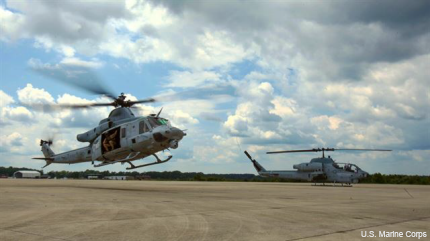Tactical data link puts Marine units on the same page
Replacing a paper-based process, Marines use Link 16 to integrate field radios and tablets to connect helicopters, UAVs and ground forces.

A UH-1Y Huey and AH-1W Super Cobra take off during the interoperability exercise.
The Marine Corps, which has been working to improve interoperability with various radio and communications equipment, recently tested a data link that can integrate operations among helicopter crews, unmanned aerial vehicles and ground forces, in the process replacing a paper-based operation.
The exercise at Marine Corps Air Station Cherry Point, N.C., involved the Marine’s Light Attack Helicopter Squadron 467, Unmanned Aerial Vehicle Squadron 2 and Marine Corps Forces, Special Operations Command. It made use of Link 16, a military tactical data network used by U.S., NATO and other forces to facilitate data interoperability between various aircraft pilots and joint terminal attack controllers – the soldiers on the ground coordinating targets for airstrikes.
The exercise “focused on integrating field radios and commercial off-the-shelf tablet systems to rapidly and securely pass converted Link 16 messages to HMLA aircraft in a tactical training exercise,” Capt. Justin Pavlischek, the intelligence officer with VMU-2, said in a release.
“[D]igital interoperability is the way the Marine Corps will be able to communicate between multiple type/model/series aircraft in an objective area that is comprised of enemy threats, friendly air positions and ground forces,” said Capt. Michael Marron Jr., an AH-1W Super Cobra pilot with HMLA-467. “A lot of our systems have requirements and are difficult to modify… We overcome that by leveraging a specific combination of current technology to provide access to two tactical networks and move some specific messages between those networks – in this case Link 16 and ANW2.”
This access can have much wider reverberations for better communication between both manned and unmanned aircraft and new close air support solutions such as the Kinetic Integration Lightweight Software Individual Tactical Combat Handheld, or KILSWITCH, which enable greater situational awareness in calling for close air support. Marines tested KILSWITCH during the spring, using Android tablets to identify targets and send the targeting information to an MV-22 Osprey, which then delivered a simulated strike in just over four minutes, well under the goal of six minutes.
“For the rotary-wing aircraft, up until recently, the Marine Corps has been using paper maps and objective area diagrams to plot friendly and enemy locations using a pen or pencil,” Marron said. “Now with tablets, we have modern technology in an aircraft that is 30 years old. It allows us to tap into a tactical picture that was previously out of our reach.”
According to Capt. Christopher Cain, KILSWITCH enables those constructing attack briefs to send them electronically through a tablet, which will allow for faster feedback and overall greater situational awareness.
The capability of unmanned aircraft to loiter nearly continuously provides a suitable model for future payloads that will increase the range of existing digital networks in disparate battlefields as well as greater coordination in close air support and ISR.




